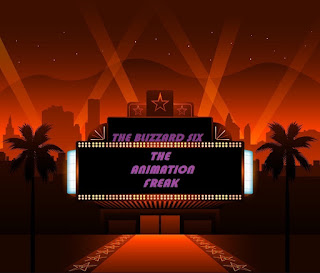The Animation Freak. Rudolph the Red-Nosed Reindeer. Romeo Muller.
The Animation Freak.
Rudolph the Red-Nosed Reindeer.
I added the film above I hope it plays for you. I hope I don't get in trouble for posting it here.
Donner, Santa's lead reindeer, and his wife have a new fawn named Rudolph. They are surprised to find out he was born with a glowing red nose. Donner attempts to first cover Rudolph's nose with mud, and later use a fake nose, so he will fit in with the other reindeer. The following spring, Rudolph goes out for the reindeer games, where the new fawns learn to fly and are scouted by Santa for future sleigh duty. Rudolph meets a doe named Clarice, who tells him he is cute, making Rudolph fly. While he celebrates with the other bucks, Rudolph's fake nose pops off, causing the other reindeer to mock him and Coach Comet to expel him.
Rudolph meets and joins Hermey, a misfit elf who left Santa's workshop because he wants to be a dentist, and Yukon Cornelius, a prospector who has spent his life searching for silver and gold. After escaping the Abominable Snow Monster, all three land on the Island of Misfit Toys. It is a place where unloved or unwanted toys reside with their ruler, a winged lion named King Moonracer, who brings the toys to the island until he can find homes and children who will love them. The king allows them to stay one night on the island and asks them to ask Santa to find homes for them. Rudolph leaves on his own, worried that his nose will endanger his friends.
Time passes and Rudolph, now a young stag, returns home to find that his parents and Clarice have been searching for him. He then travels to the Abominable's cave, where they are being held captive. Rudolph attempts to rescue Clarice until the monster knocks him down with a stalactite. Hermey and Yukon eventually show up with a plan to help out Rudolph. Hermey lures the monster out of the cave by imitating the sound of a pig and pulls out all his teeth after Yukon knocks him out. Yukon drives the toothless monster back over a cliff and falls with it.
Rudolph, Hermey, Clarice, and the Donners return home where everyone apologizes to them. Yukon returns with a tamed Abominable, now trained to trim a Christmas tree, explaining that the monster's bouncing ability saved their lives. Christmas Eve comes and while everybody is celebrating, Santa announces that a big snowstorm is approaching, forcing him to cancel Christmas. Blinded by Rudolph's bright nose, he changes his mind and asks Rudolph to lead the sleigh. Rudolph accepts, and their first stop is the Island of Misfit Toys.
The TV special, with the teleplay by Romeo Muller, introduced several new characters inspired by the song's lyrics. Muller told an interviewer shortly before his death that he would have preferred to base the teleplay on May's original book, but could not find a copy. Other than Burl Ives, all characters were portrayed by Canadian actors recorded at RCA studios in Toronto under the supervision of Bernard Cowan.
Rankin and Bass chose Canadian voice actors for two reasons. First, while the last radio dramas in the U.S. had ended production a few years previously, many were still being produced in Canada, giving the producers a large talent pool to choose from. Second, Rankin and Bass, financially stretched while making Tales of the Wizard of Oz a few years earlier, had been able to complete that series only due to the lower labor costs in Canada.
Ives' parts were recorded later. He and his character were added to the cast just before the end of production, after NBC and General Electric, the show's sponsor, asked Rankin and Bass to add a name familiar to audiences to the cast. Character designer Antony Peters intentionally made the Sam the Snowman character resemble Ives.
After the script, concept designs and storyboards for Rudolph were done by Arthur Rankin, Jr. and his staff of artists at Rankin/Bass in New York City. The company's trademark stop motion animation process, known as "Animagic", was filmed at MOM Productions in Tokyo with supervision by Tadahito Mochinaga and associate direction by Kizo Nagashima. Besides Rudolph, Mochinaga and the rest of the Japanese puppet animation staff are also known for their partnership with Rankin/Bass on their other Animagic productions almost throughout the 1960s, from The New Adventures of Pinocchio, to Willy McBean and his Magic Machine, to The Daydreamer and Mad Monster Party.
In the original production Billie Mae Richards, who voiced Rudolph, was credited as "Billy Richards" since Rankin and Bass did not want to disclose that a woman had done the part. Puppeteer Antony Peters' name was also misspelled, as was the year of the copyright notice (which used Roman numerals), listing it as MCLXIV (year 1164) and not MCMLXIV, potentially weakening much of the copyright.
Since those involved with the production had no idea of the future value of the stop-motion puppet figures used in the production, many were not preserved. Rankin claimed in 2007 to be in possession of an original Rudolph figure. Nine other puppets—including Santa and young Rudolph—were given to a secretary, who gave them to family members. Eventually seven were discarded. In 2005, the remaining two puppets of Rudolph and Santa were appraised on Antiques Roadshow; the episode aired in 2006 on PBS. At that time, their appraised value was between $8,000 and $10,000. The puppets had been damaged through years of rough handling by children and storage in an attic. Toy aficionado Kevin Kriess bought Santa and Rudolph in 2005; in 2007, he had both puppets restored by Screen Novelties, a Los Angeles-based collective of film directors specializing in stop-motion animation, with puppet fabricator Robin Walsh leading the project. The figures have been shown at conventions since then. They were sold at auction on November 13, 2020. netting a $368,000 sale price, doubling the expected return. On December 22, 2020, they were donated to the Center for Puppetry Arts in Atlanta, Georgia.
Ives, and his estate since his 1995 death, received annual residuals from the show, the only actor in it to do so. "This business of residuals was new to our union, which was not quite as strong as SAG or others in the States", Soles recalled in 2014. He, Richards and the other main cast voices received only a thousand dollars over the three years after the special's original airing; it has in some years since made $100 million. While Richards said in 2000 that her compensation was a "sore subject" for her, she had no complaints about the work itself. "I feel so lucky to have something that has made such an impact on people, and it's because of the story first and foremost.
Rudolph the Red-Nosed Reindeer is a 1964 Christmas stop motion animated television special produced by Videocraft International, Ltd. (later known as Rankin/Bass Productions and currently distributed by NBCUniversal Television Distribution (later known as NBCUniversal Syndication Studios). It first aired Sunday, December 6, 1964, on the NBC television network in the United States and was sponsored by General Electric under the umbrella title of The General Electric Fantasy Hour. The special was based on the Johnny Marks song "Rudolph the Red-Nosed Reindeer" which was itself based on the poem of the same name written in 1939 by Marks' brother-in-law, Robert L. May. Since 1972, the special has aired on CBS; the network unveiled a high-definition, digitally remastered version of the program in 2005, re-scanned from the original 35 mm film elements.
As with A Charlie Brown Christmas and How the Grinch Stole Christmas, Rudolph no longer airs just once annually but several times during the Christmas and holiday season. It has been telecast every year since 1964, making it the longest continuously running Christmas TV special in the USA. The 50th anniversary of the television special was marked in 2014, and a series of postage stamps featuring Rudolph was issued by the United States Postal Service on November 6, 2014.
This was written by a man who wrote most of the Rankin/Bass specials, Romeo Muller, a creative genius and one of my idols.
Romeo Muller
Born in New York City during the Depression, it's not surprising that the work of Romeo Muller was always aimed at lifting people up in a lively, joyful spirit. It was always starting to feel a lot like Christmas in the festive TV world of the writer-producer Mr. Muller. In 1964, he ran into and befriended the associates Arthur Rankin Jr. and Jules Bass. After that point, for more than 20 years as a collaborator with the kidpic producers, Muller penned such persistent TV Christmas fare as Rudolph the Red-Nosed Reindeer (1964), The Little Drummer Boy (1968), Frosty the Snowman (1969), and Santa Claus Is Comin' to Town (1970). Thanks to Muller's teleplays, five other Rankin-Bass productions did not neglect other legal holidays. Here Comes Peter Cottontail (1971), _Rudolph's Shiny New Year (1975) (TV)_, and The Easter Bunny Is Comin' to Town (1977) left the Christmas spirit rest a little. Two feature films owe writing credits to Muller: the lavish live action musical, Marco (1973), and Pinocchio's Christmas (1980), a puppet production. Muller also wrote for several Saturday morning cartoon series, as well as many other children's TV specials. He even once attempted to tackle adaptations of _Hobbit, The (1978) (TV)_, though his writing was criticized by fans of the book for being too simplified. Of course, Muller's own fans argue that his writing style was in fact, always simple, and that was what made his movies full of such clear emotional brevity. Noel (1992), which aired on NBC during the 1992 Christmas season, was Muller's final Christmas calling card. It was narrated by Charlton Heston and aired just a few weeks before Muller's death which occurred, interestingly enough, during the holiday season between Christmas and New Year's.









Comments
Post a Comment